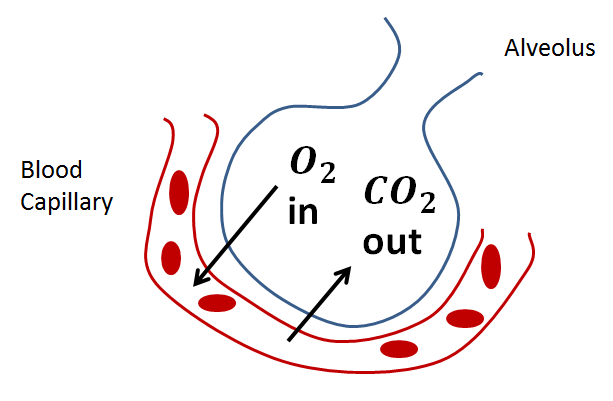
How does the blood absorb oxygen in the lungs?
Answer
387.3k+ views
Hint: Respiration is the process in which the gases such as carbon dioxide and oxygen are exchanged between the blood and external environment. During respiration, the complex substances (such as carbohydrates) are broken down to form simpler substances like water and carbon dioxide. Oxygen is utilized during this process. The synthesis of ATP takes place with the help of energy produced during this process.
Complete answer:
The respiratory system helps in respiration. It involves the exchange of gases between the lungs and body tissues. The alveoli of the lungs are responsible for the exchange of gases between the blood and surroundings. The following steps help the blood to absorb oxygen in the lungs:
When we breathe air, it reaches the alveoli of the lungs to supply oxygen. At the alveolar site, the partial pressure of oxygen is higher than the partial pressure of carbon dioxide. Hence when the impure blood reaches the alveolar capillaries, the oxygen binds with haemoglobin and forms oxyhaemoglobin in the capillary blood.
The oxyhaemoglobin is acidic in nature and thus it helps in the breakdown of sodium bicarbonate (
Hence due to the high concentration of oxygen at the alveoli, the oxygen leaves the alveolar site and enters the red blood cells and binds with the haemoglobin. After that the pure blood which carries oxygen reaches to all cells and tissues of the body to supply oxygen there for various cellular activities. At the tissue level, the carbon dioxide diffuses into the blood and reaches the alveoli of the lungs from where it is exhaled out (released outside the body) through the nose.

Note:
The partial pressure gradient helps in the movement of gases i.e. from high partial pressure to low partial pressure. In the alveolar site, the gas exchange between the alveoli and the blood capillaries takes place by simple diffusion.
Complete answer:
The respiratory system helps in respiration. It involves the exchange of gases between the lungs and body tissues. The alveoli of the lungs are responsible for the exchange of gases between the blood and surroundings. The following steps help the blood to absorb oxygen in the lungs:
When we breathe air, it reaches the alveoli of the lungs to supply oxygen. At the alveolar site, the partial pressure of oxygen is higher than the partial pressure of carbon dioxide. Hence when the impure blood reaches the alveolar capillaries, the oxygen binds with haemoglobin and forms oxyhaemoglobin in the capillary blood.
The oxyhaemoglobin is acidic in nature and thus it helps in the breakdown of sodium bicarbonate (
Hence due to the high concentration of oxygen at the alveoli, the oxygen leaves the alveolar site and enters the red blood cells and binds with the haemoglobin. After that the pure blood which carries oxygen reaches to all cells and tissues of the body to supply oxygen there for various cellular activities. At the tissue level, the carbon dioxide diffuses into the blood and reaches the alveoli of the lungs from where it is exhaled out (released outside the body) through the nose.

Note:
The partial pressure gradient helps in the movement of gases i.e. from high partial pressure to low partial pressure. In the alveolar site, the gas exchange between the alveoli and the blood capillaries takes place by simple diffusion.
Latest Vedantu courses for you
Grade 9 | CBSE | SCHOOL | English
Vedantu 9 CBSE Pro Course - (2025-26)
School Full course for CBSE students
₹37,300 per year
Recently Updated Pages
Master Class 9 General Knowledge: Engaging Questions & Answers for Success

Master Class 9 English: Engaging Questions & Answers for Success

Master Class 9 Science: Engaging Questions & Answers for Success

Master Class 9 Social Science: Engaging Questions & Answers for Success

Master Class 9 Maths: Engaging Questions & Answers for Success

Class 9 Question and Answer - Your Ultimate Solutions Guide

Trending doubts
State and prove Bernoullis theorem class 11 physics CBSE

What are Quantum numbers Explain the quantum number class 11 chemistry CBSE

Who built the Grand Trunk Road AChandragupta Maurya class 11 social science CBSE

1 ton equals to A 100 kg B 1000 kg C 10 kg D 10000 class 11 physics CBSE

State the laws of reflection of light

One Metric ton is equal to kg A 10000 B 1000 C 100 class 11 physics CBSE




